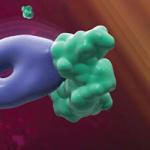
Tamas Balla, M.D.,Ph.D.
Senior Investigator
Section on Molecular Signal Transduction
NICHD/DIR
Research Topics
Phosphoinositide Messengers in Cellular Signaling and Trafficking
The Section on Molecular Signal Transduction investigates signal transduction pathways that mediate the actions of hormones, growth factors, and neurotransmitters in mammalian cells, with special emphasis on the role of phosphoinositide-derived messengers. Phosphoinositides constitute a small fraction of the cellular phospholipids but play critical roles in the regulation of many signaling protein complexes that assemble on the surface of cellular membranes. Phosphoinositides regulate protein kinases and GTP-binding proteins as well as membrane transporters, including ion channels, thereby controlling many cellular processes such as proliferation, apoptosis, metabolism, cell migration, and differentiation. We focus on one family of enzymes, the phosphatidylinositol 4 (PtdIns4)–kinases (PI4Ks), that catalyze the first committed step in polyphosphoinositide synthesis. Current studies aim to (i) understand the function and regulation of several PI4Ks in the control of cellular signaling and trafficking pathways; (ii) find specific inhibitors for the individual PI4Ks; (iii) define the molecular basis of PtdIns4P–regulated pathways through identification of PtdIns4 P–interacting molecules; (iv) develop tools to analyze inositol lipid dynamics in live cells; and (v) determine the importance of the lipid-protein interactions in the activation of cellular responses by G protein–coupled receptors and receptor tyrosine kinases.
Biography
Dr. Tamas Balla received his M.D. degree from Semmelweis University, School of Medicine, Budapest, Hungary in 1979 and earned his Ph.D. from the Hungarian National Academy of Science in 1987. He was appointed as an Assistant Professor in the Department of Physiology at Semmelweis in 1979 and held this position until 1992. He did his postdoctoral training at the NICHD between 1985-87 with Dr. Kevin Catt and returned to the NIH in 1989. He became a tenure-track investigator in 1997 in the Endocrinology and Reproduction Research Branch, leading the Section of Molecular Signal Transduction and received his tenure in 2004. Currently he is a Senior Investigator leading the same Section, which is now part of the Program for Developmental Neuroscience within the NICHD, NIH. In 2009 Dr. Balla received a D.Sc. degree from the Hungarian Academy of Science, and he was elected into the Hungarian Academy of Science in 2010. Dr. Balla started his research by studying the receptors and signaling pathways mediating the actions of angiotensin II in the adrenal cortex. As it turned out, these receptors (as many others) utilize the phosphoinositide – phospholipase C -calcium – signaling cascade and the unfolding of this system turned Dr. Balla’s attention to inositol phospholipids. While studying the metabolism of Ins(1,4,5)P3, he and his colleagues discovered a novel pathway that linked Ins(1,4,5)P3 production to highly phosphorylated inositols and that these metabolites showed long-term changes after agonist stimulation. In the mid 90’s he and his colleagues were the first to discover that the signaling pool of phosphoinositides in the plasma membrane is synthesized by type III PI 4-kinases (not by the type II forms as previously believed). He led the efforts to purify and clone these enzymes from bovine adrenal and -brain and study their functions in cellular physiology. The cellular distribution of these enzymes have clearly indicated that their functions are linked to a variety of trafficking events in addition to their roles in receptor signaling. The highly localized inositide changes prompted Dr. Balla to experiment with fluorescent methods to visualize the cellular distribution and dynamics of inositol lipid changes in live cells. His group was one of the firsts to report on live cell imaging of PtdIns(4,5)P2 and PtdIns(3,4,5)P3. Since then his research has been primarily concerned with the roles of phosphatidylinositol 4-kinase enzymes in cellular trafficking and signaling. He also continues to focus on improving methods by which to visualize and manipulate phosphoinositides and other lipids in specific cellular compartments in intact living cells. Dr. Balla is member of the American Society of Cell Biology, the American Society of Biochemistry and Molecular Biology and the Hungarian Physiological Society. He has served on the Editorial Board of the Journal of Biological Chemistry and Neurochemistry International, he is currently an Associate Editor of BMC Cell Biology, Monitoring Editor of The Journal of Cell Biology and Advisory Board Member of Journal of Cell Science. He is an external member of the Hungarian Academy of Science and a Fellow of the American Society of Cell Biology. He has published over 200 articles.
Selected Publications
- Prinz WA, Toulmay A, Balla T. The functional universe of membrane contact sites. Nat Rev Mol Cell Biol. 2020;21(1):7-24.
- Baba T, Alvarez-Prats A, Kim YJ, Abebe D, Wilson S, Aldworth Z, Stopfer MA, Heuser J, Balla T. Myelination of peripheral nerves is controlled by PI4KB through regulation of Schwann cell Golgi function. Proc Natl Acad Sci U S A. 2020;117(45):28102-28113.
- Baba T, Toth DJ, Sengupta N, Kim YJ, Balla T. Phosphatidylinositol 4,5-bisphosphate controls Rab7 and PLEKHM1 membrane cycling during autophagosome-lysosome fusion. EMBO J. 2019;38(8):e100312.
- Alvarez-Prats A, Bjelobaba I, Aldworth Z, Baba T, Abebe D, Kim YJ, Stojilkovic SS, Stopfer M, Balla T. Schwann-Cell-Specific Deletion of Phosphatidylinositol 4-Kinase Alpha Causes Aberrant Myelination. Cell Rep. 2018;23(10):2881-2890.
- Sohn M, Korzeniowski M, Zewe JP, Wills RC, Hammond GRV, Humpolickova J, Vrzal L, Chalupska D, Veverka V, Fairn GD, Boura E, Balla T. PI(4,5)P2 controls plasma membrane PI4P and PS levels via ORP5/8 recruitment to ER-PM contact sites. J Cell Biol. 2018;217(5):1797-1813.
Related Scientific Focus Areas



Molecular Biology and Biochemistry
View additional Principal Investigators in Molecular Biology and Biochemistry


This page was last updated on Monday, January 5, 2026